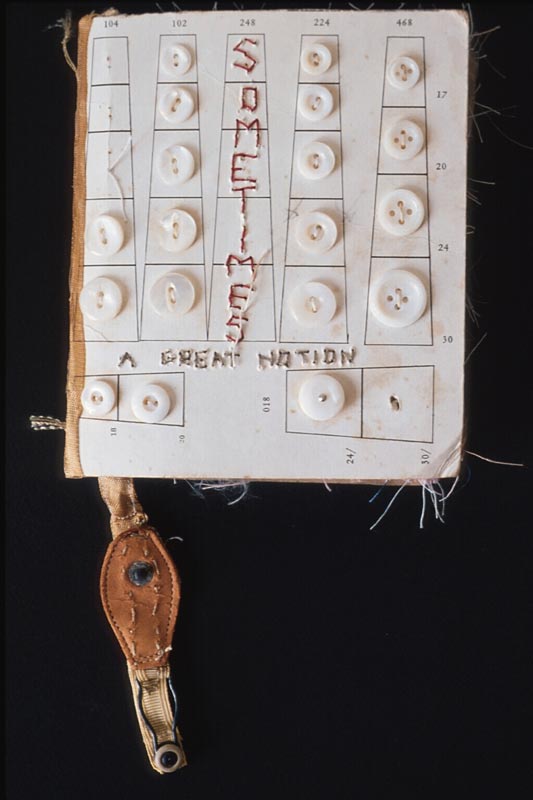

Henry Stamper and his coworker haul the deer into their boat, but as they near the shore, the buck jumps overboard and swims, frantic, back out to sea. Please reload the page and try again.Ī haunting image in Notion is that of a solitary deer swimming perilously far off the Pacific coast. Whoops! There was an error and we couldn't process your subscription. Like this story? Get the latest from the Daily Yonder directly in your inbox, twice each week. Aquifers are drying up pipelines carve through the earth and its water sources chemical spills blanket coastlines.

Agricultural policies and the rise of corporate farming have pushed the American laborer off the land, so that now less than 1% of Americans pursue farming. Fifty-five percent of America’s streams no longer support healthy levels of aquatic life. Kesey’s objective is to show the value of one inch: At what point does it cost more – environmentally, mentally, physically – to live the life of the detached yeoman, the rugged libertarian? Even if this is the ideology to which one subscribes, it is increasingly difficult to follow. Many critics consider Sometimes a Great Notion to be Kesey’s best novel, but his first, One Flew over the Cuckoo’s Nest, is better known. The remainder of the story is a cascade toward doom, as Hank’s obsession with defeating the strike becomes embodied in his battle with Lee, and costs him lives, relationships and, ultimately, a place to live. ” Hank’s decision to hire his rebellious brother is the first compromise he makes, and thus the first inch he gives. The Stampers have a family motto: “Never give an inch. To satisfy production quotas – and thereby break the strike – Hank begrudgingly hires his estranged, quasi-socialist brother, Lee. The Stampers, led by patriarch Henry and his son Hank, refuse to join a union strike against a local lumber company and continue to log trees. The novel concerns a stubborn logging family in the coastal Oregon town of Wakonda. The cartoon asks a basic question: How much is one willing to surrender to maintain a lifestyle? This question is at the heart of Ken Kesey’s rural masterpiece, Sometimes a Great Notion, which turns 50 years old this year. The miner looks at the wasteland he has created and scratches his head: “Home?” With each scoop of the machine the miner pleads, “Save my job!” Once the mountain is gone his boss flies in by helicopter, fires him, and tells him to go home. Ī striking cartoon from Kentucky artist Joel Pett features a strip miner carving into a mountain with a front loader. GradeSaver, 21 February 2019 Web.A statue of Kesey stands in Portland, in his native state of Oregon.
ABOUT SOMETIMES A GREAT NOTION HOW TO
Next Section Character List Previous Section About Sometimes a Great Notion How To Cite in MLA Format Anonymous "Sometimes a Great Notion Summary". Will review the submission and either publish your submission or provide feedback. You can help us out by revising, improving and updatingĪfter you claim a section you’ll have 24 hours to send in a draft. Eventually, the house will collapse and everyone knows it, but for now, it stands on a little peninsula, a testament to Henry's stubbornness, surrounded on all sides by rapidly flowing water. These days, the river by the house has widened, and the foundation of the house is precariously close to the erosion, but Henry is too stubborn to move. One day, Leland has moved to the East Coast, but his mother dies, and he goes to Oregon to pursue revenge against Henry, or at least to settle the score in some way. wanes over the years as she slowly resigns herself to the slavery he has created for her in their marriage. Finally, there is Viv, whose love for Hank Sr. Leland doesn't fit in very well, and eventually he will end up on the East Coast. Then we meet the younger half-brother of Hank, Leland. Hank, his older son, has a powerful personality, but his insecurity poses a risk for the future of the family. His life motto is "Never Give a Inch", which defines his opinion of the strike.

Henry Stamper's opinion is conservative, philosophically and politically. The decision is heavily scrutinized from many points of view by the prose. They keep on working as if the strike is not happening.
ABOUT SOMETIMES A GREAT NOTION FREE
But the Stampers own a small company, free from unions. The union goes on strike to demand fair pay for decreased hours of labor (since technology improved, reducing the need for labor). It's the early 1960's, and the town runs on the logging industry. We meet the Stamper family who live in Wakonda, Oregon. Written by people who wish to remain anonymous We are thankful for their contributions and encourage you to make your own. These notes were contributed by members of the GradeSaver community.


 0 kommentar(er)
0 kommentar(er)
